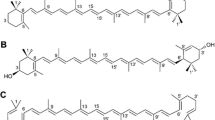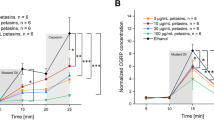Abstract
Transient receptor potential (TRP) ion channels, such as TRP vanilloid 1 and ankyrin repeat domain 1 (TRPV1 and TRPA1), are expressed on primary sensory neurons. Lutein, a natural tetraterpene carotenoid, can be incorporated into membranes and might modulate TRP channels. Therefore, the effects of the water-soluble randomly methylated-β-cyclodextrin (RAMEB) complex of lutein were investigated on TRPV1 and TRPA1 activation. RAMEB–lutein (100 μM) significantly diminished Ca2+ influx to cultured rat trigeminal neurons induced by TRPA1 activation with mustard oil, but not by TRPV1 stimulation with capsaicin, as determined with microfluorimetry. Calcitonin gene-related peptide release from afferents of isolated tracheae evoked by mustard oil, but not by capsaicin, was inhibited by RAMEB–lutein. Mustard oil-induced neurogenic mouse ear swelling was also significantly decreased by 100 μg/ml s.c. RAMEB–lutein pretreatment, while capsaicin-evoked edema was not altered. Myeloperoxidase activity indicating non-neurogenic granulocyte accumulation in the ear was not influenced by RAMEB–lutein in either case. It is concluded that lutein inhibits TRPA1, but not TRPV1 stimulation-induced responses on cell bodies and peripheral terminals of sensory neurons in vitro and in vivo. Based on these distinct actions and the carotenoid structure, the ability of lutein to modulate lipid rafts in the membrane around TRP channels can be suggested.





Similar content being viewed by others
References
Bánvölgyi Á, Pozsgai G, Brain SD et al (2004) Mustard oil induces a transient receptor potential vanilloid 1 receptor-independent neurogenic inflammation and a non-neurogenic cellular inflammatory component in mice. Neuroscience 125:449–459
Bhatt DL (2008) Anti-inflammatory agents and antioxidants as a possible “Third Great Wave” in cardiovascular secondary prevention. Am J Cardiol 101:4D–13D
Börzsei R, Pozsgai G, Bagoly T et al (2008) Inhibitory action of endomorphin-1 on sensory neuropeptide release and neurogenic inflammation in rats and mice. Neuroscience 152(1):82–88
Britton G, Liaaen-Jensen S, Pfander H (1995) Carotenoids today and challenges for the future. In: Britton G, Liaaen-Jensen S, Pfander H (eds) Carotenoids, vol 1A. Birkhäuser, Basel, Boston, Berlin, pp 13–26
Britton G, Liaaen-Jensen S, Pfander H (2008) Special molecules, special properties. In: Britton G, Liaaen-Jensen S, Pfander H (eds) Carotenoids, vol 4. Birkhäuser, Basel, Boston, Berlin, pp 1–6
Canfield LM, Hu X, White KM, Jacobsen NE, Mangelsdorf DJ (1999) β-Carotene oxidation products inhibit growth and cholesterol synthesis in breast cancer cells. 12th International Carotenoid Symposium, Cairns, Australia. Abstract 6A-4:191
Cevikbas F, Steinhoff A, Homey B, Steinhoff M (2007) Neuroimmune interactions in allergic skin diseases. Curr Opin Allergy Clin Immunol 7(5):365–373
Corbin J, Méthot N, Wang HH, Baenziger JE, Blanton MP (1998) Secondary structure analysis of individual transmembrane segments of the nicotinic acetylcholine receptor by circular dichroism and Fourier transform infrared spectroscopy. J Biol Chem 273(2):771–777
Dart C (2010) Lipid microdomains and the regulation of ion channel function. J Physiol 588:3169–3178
Geppetti P, Materazzi S, Nicoletti P (2006) The transient receptor potential vanilloid 1: role in airway inflammation and disease. Eur J Pharmacol 533(1–3):207–214
Geppetti P, Nassini R, Materazzi S, Benemei S (2008) The concept of neurogenic inflammation. BJU Int 101(Suppl 3):2–6
Garcia-Anoveros J, Nagata K (2007) Trpa1. Handb Exp Pharmacol 179:347–362
Hänninen O, Kaartinen K, Rauma AL et al (2000) Antioxidants in vegan diet and rheumatic disorders. Toxicology 155:45–53
Helyes Z, Pintér E, Németh J et al (2001) Anti-inflammatory effect of synthetic somatostatin analogs in the rat. Br J Pharmacol 134:1571–1579
Helyes Z, Pintér E, Németh J, Szolcsányi J (2003) Pharmacological targets for the inhibition of neurogenic inflammation. Curr Med Chem 2:191–218
Helyes Z, Pintér E, Németh J et al (2006) Effects of the somatostatin receptor subtype 4 selective agonist J-2156 on sensory neuropeptide release and inflammatory reactions in rodents. Br J Pharmacol 149:405–415
Helyes Z, Pintér E, Szolcsányi J (2009) In: Kovács M, Merchenthaler I (eds) Regulatory role of sensory neuropeptides in inflammation, in neuropeptides and peptide analogs, vol 7. Research Signpost, Kerala, India, pp 111–141
Horváth Gy, Molnár P, Deli J et al (2009) Karotinoidok hatásának vizsgálata neurogén gyulladásos folyamatokra in vivo egérmodellekben. Congressus Pharmaceuticus Hungaricus XIV. Budapest, Abstract (P-26). Gyógyszerészet Supplementum 11(Supl. I):S83
Horvárth Gy, Molnár P, Farkas Á, Szabó LGy, Turcsi E, Deli J (2010) Separation and identification of carotenoids in flowers of Chelidonium majus L. and inflorescenses of Solidago canadensis L. Chromatographia Supplement 71:103–108
Iványi R, Németh K, Visy J, Szeman J, Szente L, Simonyi M (2008) Water soluble carotenoid/CD complexes: preparation, characterization. The 14th International Cyclodextrins Symposium—Kyoto, Japan, Abstract book no. P1-29
Johnson EJ, Krinsky NI (2009) Carotenoids and coronary heart disease. In: Britton G, Liaaen-Jensen S, Pfander H (eds) Carotenoids, vol 1A. Birkhäuser, Basel, Boston, Berlin, pp 287–300
Kemény Á, Horváth Gy, Molnár P et al (2010a) Effects of carotenoids on skin inflammation in in vivo mice models. IBRO International Workshop, Pécs. Abstract P4–16:26
Kemény Á, Reglődi D, Cseharovszky R et al (2010b) Pituitary adenylate cyclase-activating polypeptide deficiency enhances oxazolone-induced allergic contact dermatitis in mice. J Mol Neurosci 42:443–449
Krinsky NI (1989) Carotenoids in medicine. In: Krinsky NI, Mathews-Roth MM, Taylor RF (eds) Carotenoids: chemistry and biology, I. Plenum, New York, pp 279–291
Krinsky NI (1998) The antioxidant and biological properties of the carotenoids. Annu NY Acad Sci 854:443–447
Krinsky NI, Johnson EJ (2005) Carotenoid actions and their relation to health and disease. Mol Aspects Med 26:459–516
Liu M, Huang W, Wu D, Priestley JV (2006) TRPV1, but not P2X, requires cholesterol for its function and membrane expression in rat nociceptors. Eur J Neurosci 24(1):1–6
Mayne ST, Wright ME, Cartmel B (2009) Epidemiology and intervention trials. In: Britton G, Liaaen-Jensen S, Pfander H (eds) Carotenoids, vol 5. Birkhäuser, Basel, Boston, Berlin, pp 191–210
McNulty H, Byun J, Lockwood SF, Jacob RF, Mason RP (2007) Differential effects of carotenoids on lipid peroxidation due to membrane interactions: X-ray diffraction analysis. Biochim Biophys Acta 1768:167–174
McNulty H, Jacob RF, Mason RP (2008) Biologic activity of carotenoids related to distinct membrane physicochemical interactions. Am J Cardiol 101:20D–29D
Molnár P, Kawase M, Motohashi N (2005) Isolation, crystallization and handling of carotenoids and (E/Z)-isomerization of carotenoids. In: Motohashi N (ed) Functional polyphenols and carotenoids with antioxidative action. RSFLASH, Kerala, pp 111–131, a review book series of Chem Pharm Sci
Nilius B (2007) Transient receptor potential (TRP) cation channels: rewarding unique proteins. Bull Mém Acad R Méd Belg 162(3–4):244–253
Nishino H, Murakoshi M, Tokuda H, Satomi Y (2009) Cancer prevention by carotenoids. Arch Biochem Biophys 483:165–168
Palozza P, Serini S, Ameruso M, Verdecchia S (2009) Modulation of intracellular signalling pathways by carotenoids. In: Britton G, Liaaen-Jensen S, Pfander H (eds) Carotenoids, vol 5. Birkhäuser, Basel, Boston, Berlin, pp 211–234
Pashkow FJ, Watumull DG, Campbell CL (2008) Astaxanthin: a novel potential treatment for oxidative stress and inflammation in cardiovascular disease. Am J Cardiol 101:58D–68D
Pfander H (1992) Carotenoids: an overview in methods in enzymology, vol 213. Academic, New York, pp 3–31
Quasim T, McMillan DC, Talwar D, Sattar N, O'Reilly J, Kinsella J (2003) Lower concentrations of carotenoids in the critically-ill patient are related to a systemic inflammatory response and increased lipid peroxidation. Clin Nutr 22(5):459–462
Rock CL (2009) Carotenoids and cancer. In: Britton G, Liaaen-Jensen S, Pfander H (eds) Carotenoids, vol 5. Birkhäuser, Basel, Boston, Berlin, pp 269–286
Schiedt K, Liaaen-Jensen S (1995) Isolation and analysis. In: Britton G, Liaaen-Jensen S, Pfander H (eds) Carotenoids, vol 1A. Birkhäuser, Basel, Boston, Berlin, pp 109–144
Schumacher MA (2010) Transient receptor potential channels in pain and inflammation: therapeutic opportunities. Pain Pract 10(3):185–200
Simons K, Toomre D (2000) Lipid rafts and signal transduction. Nat Rev Mol Cell Biol 1:31–39
Sjögren B, Svenningsson P (2007) Depletion of the lipid raft constituents, sphingomyelin and ganglioside, decreases serotonin binding at human 5-HT7(a) receptors in HeLa cells. Acta Physiol 190:47–53
Szolcsányi J (2002) Capsaicin receptor as target molecule on nociceptors for development of novel analgesic agents. In: Kéri G, Tóth I (eds) Molecular pathomechanisms and new trends in drug research. Taylor and Francis, London, pp 319–333
Szolcsányi J (2004) Forty years in capsaicin research for sensory pharmacology and physiology. Neuropeptides 38(6):377–384
Szolcsányi J (2008) Hot target on nociceptors: perspectives, caveats and unique features. Br J Pharmacol 155(8):1142–1144
Szőke É, Zs B, Csernoch L, Czéh G, Szolcsányi J (2000) Interacting effects of capsaicin and anandamide on intracellular calcium in sensory neurons. Neuroreport 11:1949–1952
Szőke É, Börzsei R, Tóth DM et al (2010) Effect of lipid raft disruption on TRPV1 receptor activation of trigeminal sensory neurons and transfected cell line. Eur J Pharmacol 628(1–3):67–74
Tapiero H, Townsend DM, Tew KD (2004) The role of carotenoids in the prevention of human pathologies. Biomed Pharmacother 58:100–110
Wiśniewska A, Draus J, Subczynski WK (2003) Is a fluid-mosaic model of biological membranes fully relevant? Studies on lipid organization in model and biological membranes. Cell Mol Biol Lett 8(1):147–159
Wisniewska A, Widomska J, Subczynski WK (2006) Carotenoid-membrane interactions in liposomes: effect of dipolar, monopolar, and nonpolar carotenoids. Acta Biochim Pol 53(3):475–484
Yaping Z, Wenli Y, Weile H, Ying Y (2003) Anti-inflammatory and anticoagulant activities of lycopene in mice. Nutr Res 23(11):1591–1595
Acknowledgements
The authors thank Anikó Hirné Perkecz for the preparation of the histological slides and Dániel Tóth for technical assistance. Attila Dévay, the Head of Institute of Pharmaceutical Technology and Biopharmacy, for technical support. Our work was supported by OTKA K60121, K76176 K73044, K78059, ETT 03-380/2009, ETT 04-364/2009 and the “Science, Please! Research Teams on Innovation” programme (SROP-4.2.2/08/1/2008-0011) and Developing Competitiveness of Universities in the South Transdanubian Region (SROP-4.2.1.B-10/2/KONV-2010-0002). Györgyi Horváth was supported by PTE ÁOK KA-34039-35/2009 grant.
Author information
Authors and Affiliations
Corresponding author
Rights and permissions
About this article
Cite this article
Horváth, G., Szőke, É., Kemény, Á. et al. Lutein Inhibits the Function of the Transient Receptor Potential A1 Ion Channel in Different In Vitro and In Vivo Models. J Mol Neurosci 46, 1–9 (2012). https://doi.org/10.1007/s12031-011-9525-3
Received:
Accepted:
Published:
Issue Date:
DOI: https://doi.org/10.1007/s12031-011-9525-3




